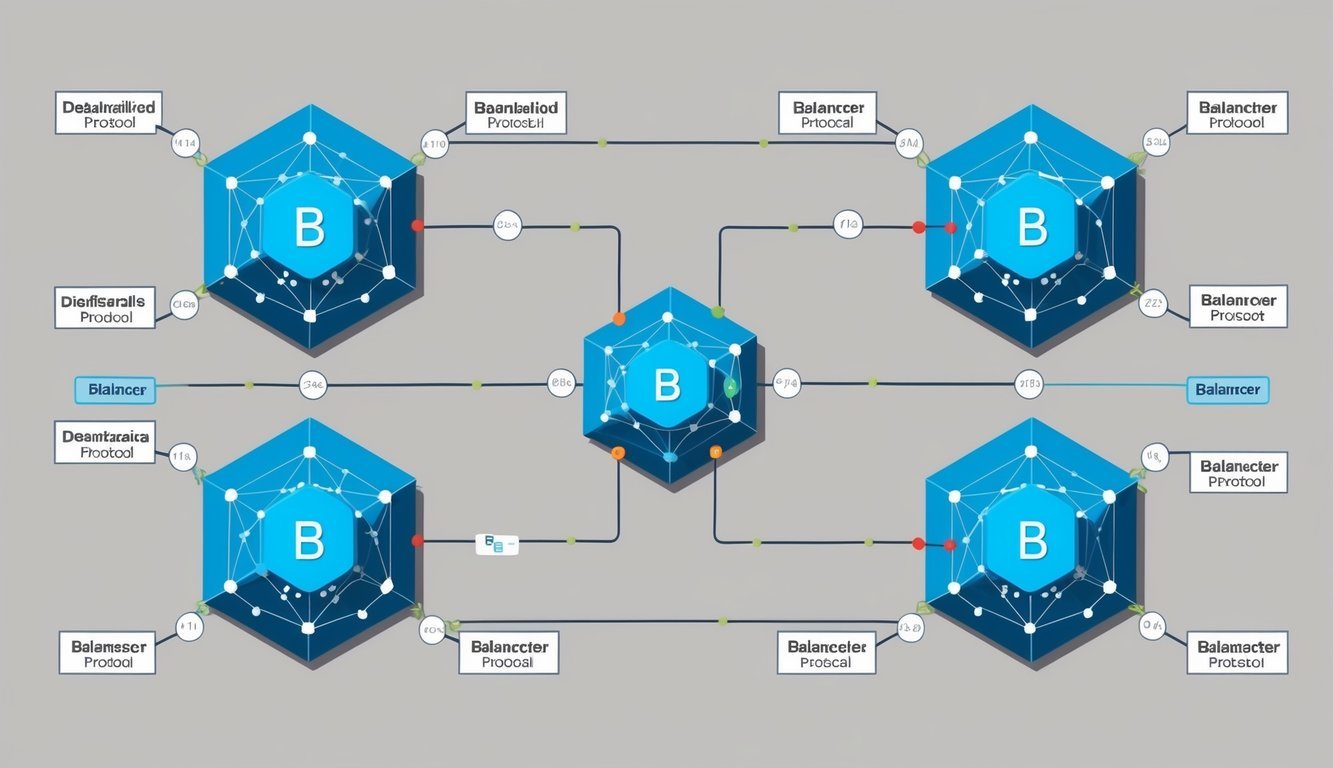Balancer (BAL) is shaking up the world of decentralized finance. It’s a new way to trade cryptocurrencies without relying on traditional exchanges.
Balancer works like a smart index fund, letting you create and manage pools of different crypto assets.

You can think of Balancer as a big digital mixing bowl. You put in various cryptocurrencies, and it keeps them balanced automatically. This system makes it easy for you to trade one crypto for another without the need for a middleman.
The BAL token is at the heart of the Balancer system. It gives you a say in how Balancer runs and grows. By holding BAL, you’re not just watching from the sidelines – you’re part of the team calling the shots.
Key Takeaways
- Balancer lets you trade cryptocurrencies directly without middlemen
- You can create and manage pools of different crypto assets
- The BAL token gives you voting rights in Balancer’s future
Understanding Balancer Protocol

Balancer Protocol is a cool way to trade crypto without middlemen. It uses smart math to make trading fair and easy for everyone.
Automated Market Makers and Liquidity Pools
Balancer is an automated market maker (AMM) that uses liquidity pools. These pools are like big pots of different crypto tokens.
When you want to trade, you don’t need to find another person to swap with. The pool does it for you automatically. This makes trading super fast and simple.
Balancer’s pools are flexible. They can hold up to 8 different tokens in any mix you want. This is pretty unique and lets you create custom trading options.
The smart contracts that run these pools use complex math to keep prices fair. As people trade, the pools adjust to keep everything balanced.
The Role of BAL Token in Governance
The BAL token is the key to having a say in how Balancer works. It’s called a governance token.
When you hold BAL tokens, you get voting power. You can suggest changes to how Balancer runs and vote on other people’s ideas.
Some things you might vote on:
- Changing trading fees
- Adding new features
- Updating how rewards work
The more BAL you have, the more voting power you get. This way, people who are really invested in Balancer have a bigger say in its future.
BAL tokens also give you a share of the fees Balancer earns from trades. So holding them can be rewarding in more ways than one.
Participating in the Balancer Ecosystem

Balancer offers several ways to get involved and potentially earn rewards. You can provide liquidity, manage assets, or stake tokens to support the network.
Becoming a Liquidity Provider
To join Balancer as a liquidity provider, you’ll need to add tokens to a pool. This helps traders swap assets and can earn you fees. Here’s how to start:
- Connect your wallet to the Balancer app
- Choose a pool or create your own
- Deposit your tokens
The amount you earn depends on the pool’s trading volume and your share of the liquidity. It’s important to watch for impermanent loss, which can happen when asset prices change.
Balancer lets you create custom pools with up to 8 tokens. This flexibility is great for trying different strategies.
Asset Managers and Liquidity Bootstrapping Pools
As an asset manager on Balancer, you can put idle funds to work. You might lend them out or use them in yield farming strategies.
Liquidity Bootstrapping Pools (LBPs) are a special type of pool. They’re designed for token sales and can help prevent price manipulation. Here’s what makes LBPs unique:
- They start with a high token price that gradually lowers
- The pool’s weights change over time
- This setup can lead to fairer distribution and less volatility
If you’re launching a new token, an LBP could be a good option to consider.
Rewards through Liquidity Mining and Staking
Balancer rewards active participants with BAL tokens. You can earn these through liquidity mining by adding tokens to certain pools.
The amount of BAL you get depends on factors like:
- The pool’s liquidity
- Your share of the pool
- The types of tokens in the pool
You can also stake your BAL tokens to earn more rewards and have a say in governance decisions. This process is called veBAL.
To start staking:
- Go to the Balancer staking page
- Lock up your BAL tokens
- Receive veBAL in return
The longer you lock your tokens, the more voting power and rewards you can get.
Economic and Trading Mechanics
Balancer’s economic system is designed to benefit both traders and liquidity providers. You’ll find unique features that make trading efficient and rewarding. Let’s explore the key aspects that make Balancer stand out in the DeFi space.
Trading Fees and Swap Fees
When you trade on Balancer, you’ll encounter two types of fees: trading fees and swap fees. Trading fees go to liquidity providers as a reward for their contribution. Swap fees, on the other hand, are collected by the Balancer protocol itself.
The fees on Balancer are generally lower compared to traditional exchanges. This makes it an attractive option for traders looking to save on costs.
Here’s a quick breakdown of fees:
- Trading fees: 0.1% to 1% (varies by pool)
- Swap fees: 0.01% to 0.05%
Remember, these fees can change based on market conditions and governance decisions.
Managing Impermanent Loss
Impermanent loss is a risk you face when providing liquidity to any automated market maker (AMM) like Balancer. It happens when the price of your deposited assets changes compared to when you deposited them.
To help manage this risk, Balancer offers:
- Diverse pool options
- Customizable weight ratios
These features allow you to create strategies that might reduce your exposure to impermanent loss. For example, you can create pools with stable assets to minimize price fluctuations.
Balancer also introduces innovative concepts like Smart Pools, which can automatically adjust weights to optimize returns and reduce risks.
Balancer Pools Types and Characteristics
Balancer offers various pool types to suit different needs:
-
Private Pools: You have full control over these pools. You can set custom parameters and decide who can add or remove liquidity.
-
Smart Pools: These are managed by smart contracts. They can automatically rebalance or change fees based on predefined rules.
-
Liquidity Bootstrapping Pools (LBPs): These are great for token launches. They start with a high token price that gradually decreases, preventing large buyers from snatching up all tokens at once.
Each pool type has unique characteristics:
- Private Pools: High customization, low liquidity
- Smart Pools: Automated management, medium liquidity
- LBPs: Time-bound, high initial price
Choose the pool type that best fits your trading or investment strategy. Remember, each comes with its own set of risks and rewards.
Technical Insights and Innovations
Balancer uses cool tech to make trading and managing crypto easier. It’s built on Ethereum and has some neat features that set it apart from other platforms.
Smart Contracts and Ethereum Blockchain Integration
Balancer runs on smart contracts on the Ethereum blockchain. These contracts handle all the trades and pool management automatically. You don’t need to trust a middleman – the code does all the work.
The platform uses ERC-20 tokens, which are the standard for Ethereum-based cryptocurrencies. This makes it easy to add new tokens to Balancer pools.
Balancer acts like an automated portfolio manager. It keeps your pool balanced without you having to do anything. The smart contracts adjust token ratios as prices change.
Flash Loans and Advanced DeFi Strategies
Flash loans are a cool Balancer feature. They let you borrow a ton of crypto for just one transaction. You have to pay it back in the same block, but it opens up some wild trading options.
With flash loans, you can pull off complex DeFi moves. Think arbitrage between different platforms or quick swaps to grab better prices.
Balancer’s protocol vault holds all the pooled assets. It’s like a big, shared piggy bank that the smart contracts manage. This setup lets Balancer offer unique features like flash loans and helps keep everything running smoothly.
Frequently Asked Questions

Balancer is a complex DeFi platform with unique features and tokens. Let’s explore some common questions about how it works, its upgrades, and the BAL token. Balancer facilitates automated portfolio management and liquidity provision through its innovative liquidity pools, allowing users to create custom token distributions. As the platform evolves, it continues to implement upgrades that enhance efficiency and user experience, making it a key player in the DeFi landscape. For those seeking to understand similar projects, an “orion protocol overview” can provide insights into alternative liquidity solutions and decentralized trading options available in the market.
How does Balancer differ from other DeFi platforms?
Balancer stands out as an automated market maker that lets you create custom liquidity pools. You can mix different assets in any ratio you want. This flexibility gives you more control over your investments compared to other platforms.
What’s the deal with Balancer’s version upgrades, like from v1 to v3?
Balancer keeps improving its protocol. The upgrades aim to cut costs and speed up trades. They also add new features and work better with other DeFi apps. Each version brings smoother operations and more options for users.
Can you swap tokens directly on Balancer, and if so, how?
Yes, you can swap tokens on Balancer. It works like other decentralized exchanges. You connect your wallet, pick the tokens you want to trade, and confirm the swap. The process is quick and doesn’t need a middleman.
What’s the main role of BAL tokens in the Balancer ecosystem?
BAL tokens are the heart of Balancer’s governance. When you hold BAL, you get to vote on important decisions about the platform. You can also earn BAL by providing liquidity to certain pools on the platform.
Is investing in BAL considered a smart move?
Investing in BAL can be risky, like any crypto investment. Its price changes often. Before buying, look at market trends and Balancer’s growth. Remember, crypto investments can lose value quickly.
Where can you find the source code for Balancer?
Balancer is open-source. Its code is available on GitHub. This transparency lets developers check the code and suggest improvements. It also helps build trust in the platform’s security.




